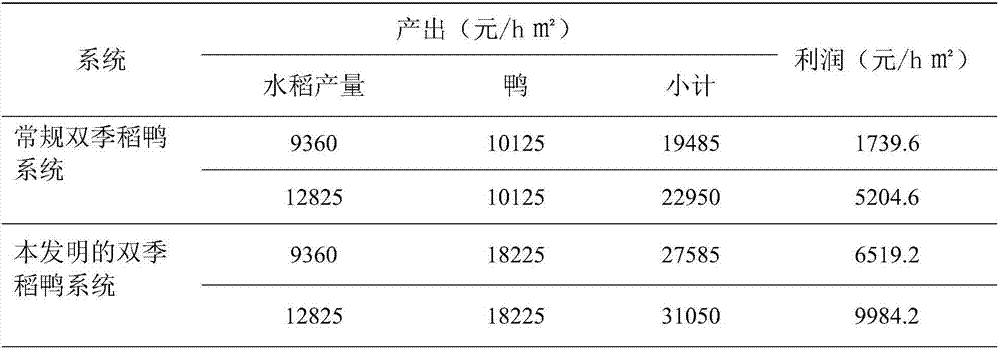Multi-season rice and duck symbiosis breeding method
A breeding method and rice-duck technology, applied in the field of ecological breeding, can solve the problems that rice-ducks are not suitable for symbiosis, prolong the symbiotic period of rice-duck, and increase income, so as to achieve the effects of increasing duck breeding density, prolonging the symbiotic period, and increasing income
- Summary
- Abstract
- Description
- Claims
- Application Information
AI Technical Summary
Problems solved by technology
Method used
Image
Examples
Embodiment 1
[0052] A kind of morning and evening rice-duck symbiosis culture method, comprises the steps:
[0053] S1. Construct the rice field ditch system, rice cultivation area, duck pen area, and feed isolation island.
[0054] S2, early rice planting;
[0055] S3, 3-7 days after planting the early rice, put the first batch of ducklings;
[0056] S4, put the second batch of ducklings 40-55 days after the early rice planting;
[0057]S5, when the early rice grows to the filling stage, harvest the first batch of ducks put in;
[0058] S6. Harvest the second batch of ducks before the mature harvest of early rice;
[0059] S7, early rice harvest;
[0060] S8, late rice planting;
[0061] S9, put the third batch of ducklings in 3-7 days after the planting of late rice;
[0062] S10, release the fourth batch of ducklings 40-55 days after the planting of late rice;
[0063] S11, when the late rice grows and develops to the grain filling stage, harvest the third batch of ducks put in; ...
Embodiment 2
[0085] A kind of symbiosis breeding method of early rice regenerated rice duck, its specific scheme is similar to embodiment 1, the difference is that the regenerated rice duck culture steps:
[0086] After the early rice is harvested, the ratooning rice is planted; when the ratooning rice is planted, the third batch of ducklings is put in; when the ratooning rice grows and develops to the filling stage, the third batch of ducklings is harvested; the ratooning rice is harvested.
[0087] Table 1 The cost comparison table (unit: yuan) of the rice raising duck system of the embodiment of the present invention 2 and the traditional rice raising duck system
[0088]
[0089] Table 2 The benefit comparison table (unit: yuan) between the system of raising ducks with rice and the system of raising ducks with traditional rice in Example 2 of the present invention
[0090]
[0091] It can be seen from the above table that after adopting the present invention, the income per hecta...
PUM
 Login to View More
Login to View More Abstract
Description
Claims
Application Information
 Login to View More
Login to View More - Generate Ideas
- Intellectual Property
- Life Sciences
- Materials
- Tech Scout
- Unparalleled Data Quality
- Higher Quality Content
- 60% Fewer Hallucinations
Browse by: Latest US Patents, China's latest patents, Technical Efficacy Thesaurus, Application Domain, Technology Topic, Popular Technical Reports.
© 2025 PatSnap. All rights reserved.Legal|Privacy policy|Modern Slavery Act Transparency Statement|Sitemap|About US| Contact US: help@patsnap.com



